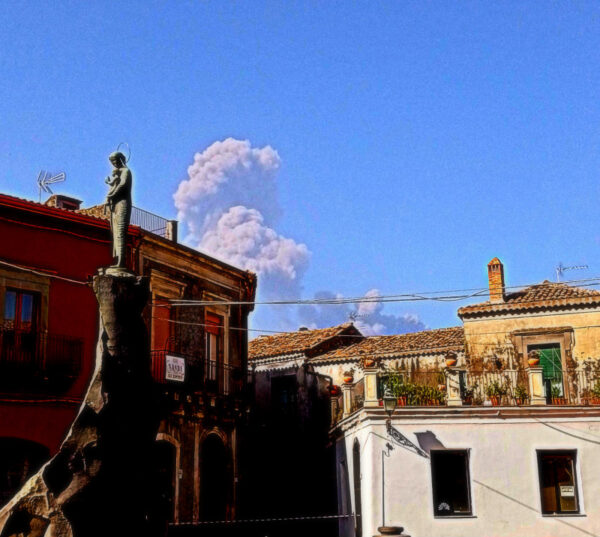The two eruptions that marked the 1920s on Etna are not connected to each other. In fact, they took place on two different sides and with a five-year break between each other. But they are linked by the danger and the feeling of disaster that they both brought with them. Rare sensations, because although Mount Etna is an active volcano, and noisy too, its lava has very few times attacked inhabitants and humans. Yet, in that decade that preceded the enormous tragedy of World War II, the volcano seemed as restless as the times full of arrogance that we were living then.
Eruption of 1923, fear in Linguaglossa
 Linguaglossa during an eruption
Linguaglossa during an eruption
This event lasted just a month, from 16 June to July 1923. It all happened on the northern side of the volcano, when after a series of seismic shocks several fractures opened along the axis of Monte Nero, above Linguaglossa. The fractures stretched from an altitude of 2500m to an altitude of 2000m, emitting rivers of lava which began a rapid descent towards the valley.
Before the end of June, the lava had already covered several cultivated fields between Linguaglossa and Castiglione and submerged the houses in the villages of Cerro and Catena, also destroying the Circumetnea railway station. After flowing down for 11 km, the fire stopped a few meters from the first houses of the urban area of Linguaglossa, thus saving it.
The eruption caused quite a stir and was reported in the newsreels of the time with great fanfare, as was typical of the style of the time. Mussolini himself wanted to go and see the devastation of the event up close, and several photos show him posing with the local authorities in front of the lava.
The 1928 eruption and the “war of the saints”
Five years after that disastrous event, while the State was still providing economic aid to the towns of Linguaglossa and Castiglione, a new eruption with fractures occurred this time on the eastern side of Etna. In fact, between 2 and 4 November, eruptive fissures opened between the Valle del Leone (2600 metres) and Ripe della Naca (1200 metres), emitting long flows of lava which in a short time overcame the arid areas at high altitude. They soon headed towards the highest villages of the volcano.
One stream of lava was aimed directly at the village of Sant’Alfio but inexplicably stopped, a few kilometers from the houses, after having
 the Ripe della Naca site
the Ripe della Naca site
set fire to chestnut groves and fields. The inhabitants of the village, however, had carried their patron saint in procession and it was thanks to him, according to them, that the fire had stopped completely. The lava that flowed from the lowest fracture, instead, continued on its way and reached the town of Mascali a few days later. The locals had also brought their saint, St Leonard, in procession, but this time the volcano did not seem “intimidated”. The lava not only entered the town, but destroyed the main church, to the great scandal of the devotees! Only a small church had been spared by the lava; it was the peripheral one of Sant’Antonino and for several years this was precisely the church of the heart of the people of Mascali. Sant’Antonino had proven to be more “attentive” than St Leonard! But over the following years, the patron saint was “forgiven” and he once again became the town’s first saint. Once the reconstruction was completed, it once again had its church overlooking the central square!
The Mascali eruption remains one of the most serious volcanic disasters of the 20th century. Even if it caused no victims, it caused the almost total obliteration of a town and the loss of many material goods of its inhabitants.
Visit the sites of the two eruptions
In order to see the lava flows of 1923 just go to Linguaglossa, in the hamlet of Catena. The town and the fields have now regained possession of the territory, but it is still possible to see the black rocks of that recent flow while, in the car, you travel along the road that connects Linguaglossa to Randazzo.
The most obvious sign of the 1928 eruption are the suggestive “lava waterfalls” of Ripe della Naca, reachable both by car and on foot with a not too difficult excursion. By car you can also get to the small church of Magazzeni, among the chestnut groves of Sant’Alfio, so to admire the place where the first lava stream miraculously stopped.
To reach Linguaglossa, follow the A18 Messina-Catania motorway, exit at Fiumefreddo and go up towards the Paesi Etnei direction. To reach Mascali and Sant’Alfio, travel on the same motorway, exiting at Giarre and following the signs for Mascali. From Mascali itself, you can quickly reach Sant’Alfio. (ALL PHOTOS BY GRAZIA MUSUMECI)